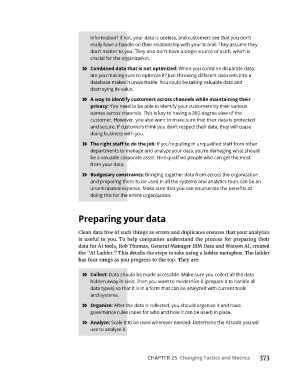Page 389 - Social Media Marketing for Dummies
P. 389
information? If not, your data is useless, and customers see that you don’t
really have a handle on their relationship with your brand. They assume they
don’t matter to you. They also don’t have a single source of truth, which is
crucial for the organization.
» Combined data that is not optimized: When you combine disparate data,
are you making sure to optimize it? Just throwing different data sets into a
database makes it unworkable. You could be taking valuable data and
destroying its value.
» A way to identify customers across channels while maintaining their
privacy: You need to be able to identify your customers by their various
names across channels. This is key to having a 360-degree view of the
customer. However, you also want to make sure that their data is protected
and secure. If customers think you don’t respect their data, they will cease
doing business with you.
» The right staff to do the job: If you’re pulling in unqualified staff from other
departments to manage and analyze your data, you’re damaging what should
be a valuable corporate asset. Hire qualified people who can get the most
from your data.
» Budgetary constraints: Bringing together data from across the organization
and preparing them to be used in all the systems and analytics tools can be an
unanticipated expense. Make sure that you can enumerate the benefits of
doing this for the entire organization.
Preparing your data
Clean data free of such things as errors and duplicates ensures that your analytics
is useful to you. To help companies understand the process for preparing their
data for AI tools, Rob Thomas, General Manager IBM Data and Watson AI, created
the “AI Ladder.” This details the steps to take using a ladder metaphor. The ladder
has four rungs as you progress to the top. They are:
» Collect: Data should be made accessible. Make sure you collect all the data
hidden away in silos. Then you want to modernize it (prepare it to handle all
data types) so that it is in a form that can be analyzed with current tools
and systems.
» Organize: After the data is collected, you should organize it and have
governance rules (rules for who and how it can be used) in place.
» Analyze: Scale it to be used wherever needed. Determine the AI tools you will
use to analyze it.
CHAPTER 25 Changing Tactics and Metrics 373

